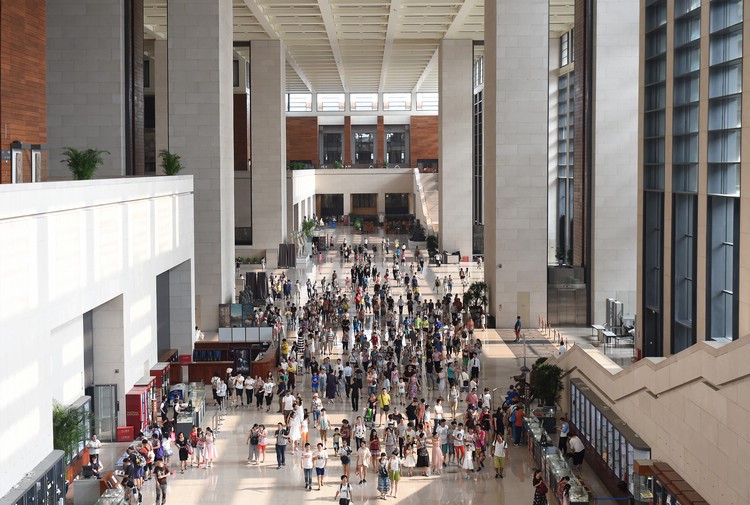How to attract Chinese museum visitors using social media?
The number of Chinese museum visitors is growing fast, with the average growth rate of around 55% from 2006 to 2015, along with the rekindled art market, according to Daxue Consulting. Xinhua News Agency (新华社), the official press agency of China, finds that museums have ranked as the eighth most popular leisure place after theme parks in China. For Chinese tourists, visiting museums abroad has also become an attractive activity. The sales of foreign museum tickets ranked fourth on Taobao (淘宝) and Tmall (天猫) after theme parks, live-action performances, and natural attractions respectively in 2016, according to our research.
Chinese tourists have also been favoring the U.S. more and more, as it is currently the sixth most popular destination for Chinese overseas tourists. Of those Chinese tourists, 36% have visited a museum in U.S., according to America National Tour Association in 2013. Museums across the world would do well to invest in attracting this surging tourism population.
Know your customer in China
Domestic museum visitors in China
Chinese museum visitors’ increasing enthusiasm is evident, as there were at least 781 million museum visitors in 2015, according to the National Bureau of Statistics of China (中国国家统计局). Among the increasing Chinese museum visitors, middle-class Chinese families account for a large share. With their increasing disposable income, many middle-class families are exploring and becoming more interested in culture and history.
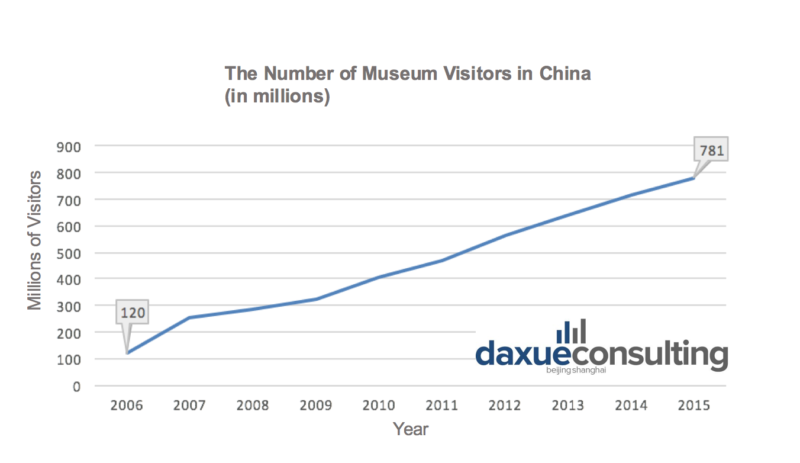
Along with the increasing number of tourists, average expenditures on culture and entertainment goods and services is rising in parallel, from 1,048 CNY in 2006 to 1,786 CNY in 2012, according to National Bureau of Statistics of China. Last year the amount of sales of related merchandise at the Palace Museum (故宫) in Beijing reached 1,000 million CNY, according to SOHU (搜狐), one of the leading companies Chinese media.
[ctt template=”2″ link=”c4N11″ via=”yes” ]We are experiencing a “Museum Tide” among overseas Chinese tourists, as due to increased wealth and interest in culture [/ctt]
Chinese museums visitors are also more willing to pay for exhibitions with more interactive experiences. More than 60 museums from over 20 districts in China participated in the May 2017 “Internet+ Chinese Culture Museum Innovation Forum” (互联网+中华文明-中国博物馆创新论坛), which focused on how to attract Chinese museum visitors through technological innovation. In this forum, Chinese museums curators discussed new ways to display their collections, like using three-dimensional digital equipment and technology to display cultural relics.
Overseas Chinese museum visitors
We have also found that middle-class tourists account for more than half of all Chinese tourists. This proportion will be even larger when it comes to overseas tourists, considering the average spending abroad is 16% higher than for domestic tourists, according to a report jointly released by China Tourism Academy (中国旅游研究院) and Ctrip (携程), a leading provider of travel services in China, in 2017.
This report shows that we are experiencing a so-called “Museum Tide” (博物馆热) among overseas Chinese tourists, as due to increased wealth and interest in culture, Chinese tourists are visiting museums in record numbers. China has overtaken Europe as the largest source of international visitors at the Asian Art Museum in California (旧金山亚洲艺术博物馆) in 2016, according to the Washington Post. In 2015, the number of Chinese visitors to The Louvre Museum (卢浮宫) in Paris doubled since 2012, reaching 820,000 in 2015, according to Xinhua News Agency. At the Metropolitan Museum of Art (大都会艺术博物馆) in New York, the number of Chinese visitors account for 13% of the total visitors, according to Tencent (腾讯).
How mobile devices are changing the way people visit museums
For the Chinese middle-class, using mobile devices, especially smartphones, has become an integral part of their lives. According to China Internet Network Information Center (CNNIC中国互联网络信息中心), around 31% of social media users belong to middle-class as of 2016. As for the usages of social media, the top three are interacting with friends (72%), news (64.3%) and engaging with and consuming other content of interest (59%).
[ctt template=”2″ link=”KcUAh” via=”no” ]The sale of foreign museum tickets on Taobao and Tmall reached 9.2 billion CNY in the past twelve months according to @DaxueConsulting[/ctt]
Changing museum visits: payment methods and behaviors
Wide-spread use of smartphones has contributed to the rise of popular mobile payments apps in China, which is changing the way Chinese museum visitors buy tickets. The penetration of smartphones in China is 950 million as of 2015, according to CNNIC. China has also overtaken the U.S. in terms of mobile e-payments transactions in 2016. As a result, a large amount of Chinese museum visitors is likely to buy tickets through mobile devices. The sale of foreign museum tickets on Taobao (淘宝) and Tmall (天猫) reached 9.2 billion CNY in the past twelve months, according to our research.
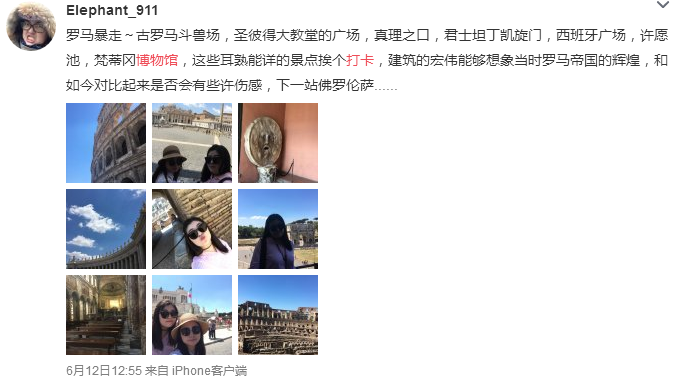
A “Check-in”(打卡) status posted by a Weibo user, which shows the cultural and tourist sites she has been to. Source: Weibo.
Popular social media apps, like Weibo and WeChat, have been some of the biggest drivers of museum tickets sales in China. App users are able to get information about exhibitions and museums directly through their official accounts on Weibo and WeChat.
Follow us on Twitter to learn more about China:
How have 淘寶網官方 Taobao on the #Chinese #internet evolved compared with its Western counterparts? https://t.co/lLdzNCZuzq
— Daxue Consulting (@DaxueConsulting) August 1, 2017
“Check-in” (打卡) is also becoming popular in China. Chinese museum visitors like to take pictures and share their experiences through social media, like with the “Moments” (朋友圈) feature on WeChat, which is popular in mainland China. According to CNNIC’s report, around 60% of Chinese social media app users will use it upload their photos and update their statuses.
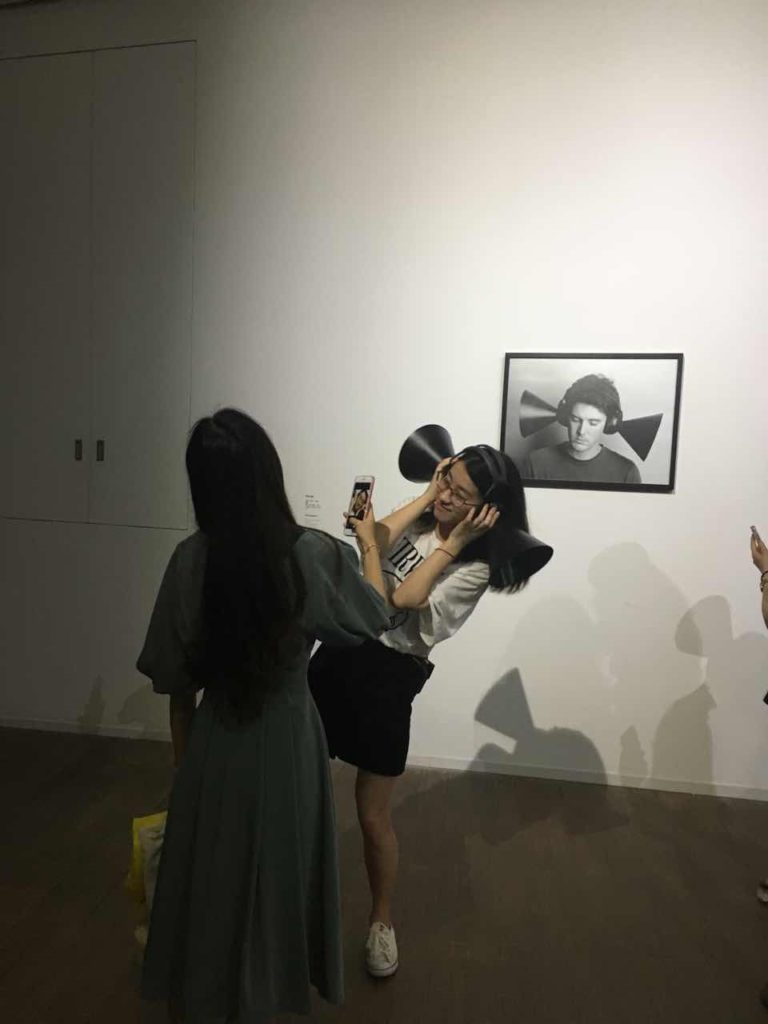
Imitating the artwork is a popular way to take photos among young Chinese museum visitors. Photo credit: Daxue Consulting.
How museums should adapt
To adapt to new trends in social media and mobile devices, 65 of 96 national first-class museums in China have established an official WeChat account (微信公众号), according to the research published by the journal Southeast Culture (东南文化). Through these platforms, Chinese museum visitors can buy tickets and access information about the museum directly on the app. For example, Power Station of Art in Shanghai (上海当代艺术博物馆) sells their exhibition tickets through their official WeChat account. The Guangdong Museum (广东省博物馆) provides a ticket reservation service that allows ticket purchases up to seven days in advance through its WeChat account.

Shanghai Power Station of Art (上海当代艺术博物馆), the first public modern art museum in China, adapting to trends with QR scan stations with WeChat. Photo credit: Daxue Consulting.
The frequent use of mobile devices has inspired museums to provide various services for visitors on their official WeChat account. By doing so, these museums can now access what Tencent now estimates are the 889 million total users on WeChat. Some of the offerings available on WeChat include services like the audio guide, which can be activated once at the museum. For instance, visitors can scan a serial number or code of an exhibit while at the Shanghai Natural History Museum (上海自然博物馆), and WeChat will bring up the corresponding audio files.
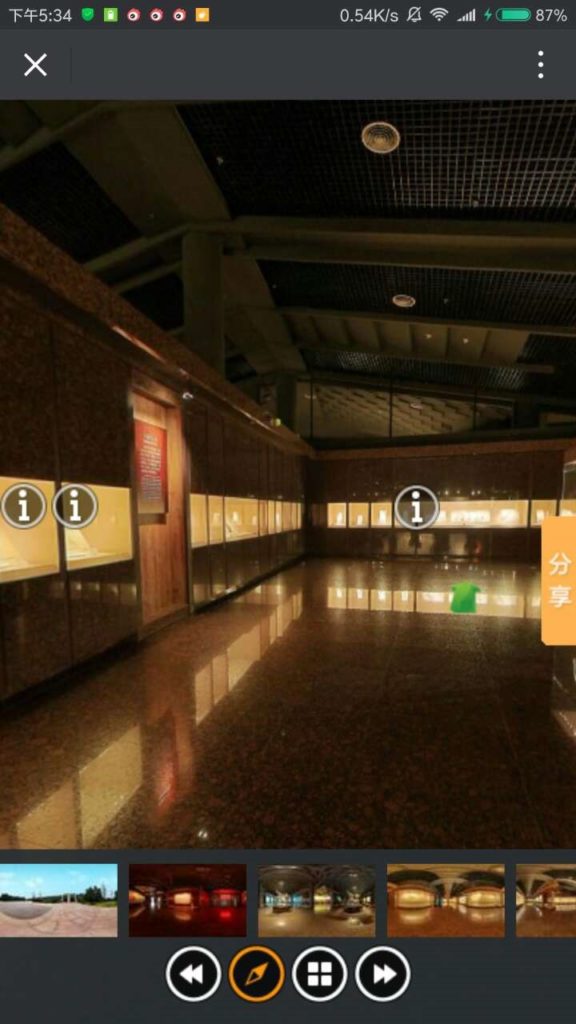
The 360° online panorama display provided by Sanxingdui Museum’s (三星堆博物馆) WeChat official account. Source: WeChat.
In addition, museums’ official WeChat accounts can even provide online panorama displays. This allows visitors to view the whole museum through a 360° online panorama display provided by Sanxingdui Museum‘s (三星堆博物馆) WeChat official account. The green arrow guides the user from one exhibition to the next, and the “i” symbol provides an explanation about the collection.
While offerings like these are great for visitors already on location, many museums are trying to embrace the rise of live-streaming in China. Alternate options like live-streaming are incredibly appealing because of the low cost associated with them. According to a recent New York Times article by Mike Ives, live-streaming presents a tremendous social and educational opportunity. For students and tourists alike, the ease of access and quality of content could be used by museums to effectively entice visitors and streamers.
The popularity of the social media experience at Chinese museums has forced museums to pay more attention to promoting the exhibits’ features rather than using traditional advertisements. More than 60% of users on WeChat used Moments to record their activities in 2016, according to a report released by Tencent in 2016. This report also shows that 61.4% of users browse the Moments of other people when they use WeChat. The frequent use of social media, in a sense, acts as free advertisement for the museums, as the museum guests will post, share, and discuss the exhibition while in attendance. So, when compared with doing the advertisements themselves, museums should adopt by using consumer feedback to attract customers.
Although foreign museums, such as the Metropolitan Museum of Art, The Louvre, and the Orsay Museum (奥赛博物馆) already have official accounts on Weibo and WeChat, their accounts still lack the ticket-purchasing, 360° online panorama display and other features that their Chinese counterparts have utilized so successfully.
How popular museums attract Chinese museum visitors: two best practices

Flower Forest, Lost, Immersed and Reborn (花之森林,迷失、沉浸与重生 ) exhibit in Beijing, 2017. The flowers bud, grow, and blossom bloom as the viewers stay, touch and step on the flowers. Photo credit: teamLab
Many recent exhibitions in China have successfully channeled social media to their advantage. For example, “James Turrell: Immersive Light” (詹姆斯•特瑞尔回顾展) has attracted over 1,000 people per week, according to Wei Wang (王薇), the exhibition’s curator. The Weibo topic about the exhibition has garnered 3.35 million views and 181 mentions since the exhibition’s opening. We have selected some other successful cases of 2017 thus far as examples of how popular exhibitions attract Chinese museum visitors using social media.
Interactive experience
In China, museum exhibitions with interactive experiences are becoming more attractive for Chinese visitors. A recent exhibition, “teamLab : Living Digital Forest and Future Park” (teamLab:花舞森林与未来游乐园), is already on track to become the most successful exhibition in the first half of 2017. The exhibition’s tickets on Damai ( 大麦网),the leading brand of ticketing services in China, are sold out until October 10th. The Weibo topic about the exhibition has over 6.75 million views and 5,340 mentions.
Before it opened on May 20 in the Pace Gallery Beijing (北京佩斯画廊), teamLab used apps like WeChat and SOHU to promote the exhibition. The exhibition also invited some Chinese celebrities, such as Chen Guanxi (陈冠希), a Hong Kong actor who has 26.72 million followers on Weibo, Wanwan (晚晚), a wanghong (网红) with 1.51 million followers on Weibo, and Liuwen (刘雯), a Chinese fashion model with 18.64 million followers on Weibo, among others to visit the exhibition. Those celebrities then posted about their experiences in the exhibition, which attracted significant attention to it from their followers.
During the exhibition period, the official Weibo account of the Pace Gallery Beijing kept in-touch with visitors through several events. For example, after noticing that many Weibo posts contained a photo of the “Exit” (安全出口) at the exhibition, Pace Beijing held a short “Luck Draw” event, where those who posted about the photo of the “Exit” were entered into a pool for winning additional tickets. The Weibo posts about the “Luck Draw” contest were forwarded hundreds of times more than what Pace Beijing had expected. Pace also interacted with users by liking and forwarding their posts.

China’s top supermodel Liuwen (刘雯)’s Weibo status about “Crystal Universe” (水晶宇宙), a part of a TeamLab exhibition, got more than 50 thousand likes and 2,608 comments on Weibo. Source: Weibo.
The Weibo posts about the exhibition captivated Chinese netizens with various interactive experiences supported by CG, interactive 4D Vision, and several digital technologies, which are the main selling points of the exhibition. For instance, in “Crystal Universe” (水晶宇宙), viewers are invited to enter and walk around in a three-dimensional “light space”, where movement affects light particles and creates changes in the scenery. Viewers can also interact with the work by using their smartphones to select elements that make up the “Crystal Universe”. In response, the light will change to the mode that was formed by the selected elements. Further, it provides an extraordinary place for taking photos, which caters to the Chinese demand for unique experiences that they can post about. There are thousands of pictures on Weibo taken by the Chinese visitors with the tag “Living digital forest and future park” (#花舞森林与未来游乐园#).
Varied experiences
Famous exhibitions that provide unique experiences and contain artwork of famous western celebrities or artists are also popular in China. In 2016, “The World of Tim Burton”(蒂姆·伯顿的异想世界) came to Shanghai, which attracted many fans who gathered to see art pieces, drawings, and other non-film creations on display. The Weibo topics about “The World of Tim Burton” garnered over 120,000 views as of June 2017.

Tim Burton on June 26th 2016, the opening day of the exhibition in Shanghai. Source: WeChat.
To promote the event, organizers cleverly invited Chinese celebrities and Weibo KOLs (Key Opinion Leaders, who have at least 1 million followers on Weibo) to attract press and fan interest.
The exhibition also attracted many of China’s top online video and streaming service platforms, like iQIYI (爱奇艺) and Youku (优酷), who came to interview Tim Burton and helped generate buzz for the eager Chinese museum visitors. The exhibition is now famous for producing the third largest visitor-turnout of any exhibit exhibition held at The Museum of Modern Art (纽约现代艺术博物馆).
To provide a unique experience to Chinese visitors, the Shanghai exhibition of “The World of Tim Burton” displayed the manuscript and a model of Miss Peregrine’s Home for Peculiar Children for the first time. The underground floor of the museum screened Tim Burton’s shorts that had not yet been released. Finally, the “Luminous area” provided a different way to see his works.
The book-signing activity of “The Art of Tim Burton” gave the Chinese visitors a rare chance to get close to their idol while in China, which of course was quite popular with Tim Burton fans.
Besides the artwork of Tim Burton on the first and second floors, the third floor of the exhibition provided a place for taking photos and selling related products such as books, models, T-shirts, and so on, which cater to Chinese museum visitors demand for social media photos and brand engagement through shopping. All of these exclusive offerings gave Chinese consumers a unique experience.
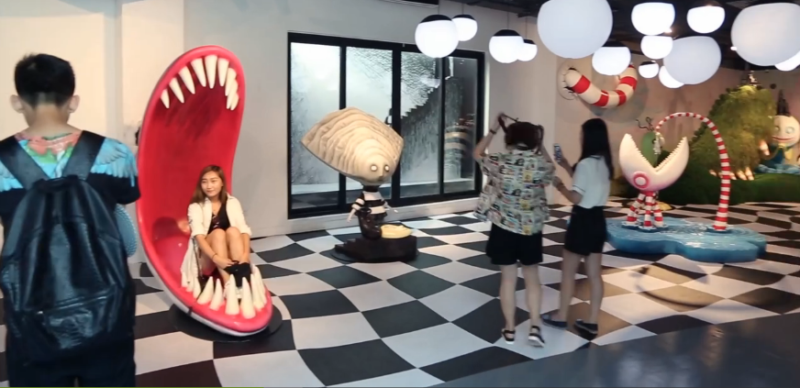
The third floor of the Time Burton exhibition in Shanghai provides the visitors a place for taking photo. Source: iQIYI.
Next expected trends for Chinese museum visitors
The characteristics of Chinese museum visitors and popular exhibitions shows several promising trends for museums in China.
Engaging Experiences
Museums will provide more unique and interactive experiences as Chinese visitors expect to engage more directly with the exhibitions through different interactive technology such as VR, AR, and other digital techniques. Those technologies will also provide them with a more interesting way to absorb the culture and interpret what artists are trying to express. For Chinese middle-class families, interesting content and educational value are their major concerns when they visit a museum with their children.
Attractive Social Media Presence
Social media will be the main way for museums to advertise, as Chinese visitors spend more time on social media and love to post, share, and discuss their experiences there. In that case, providing photo spots for them will be helpful for improving the exposure rate of the exhibition and speed at which its discussion spreads on top Chinese social media platforms.
Intuitive UX
Providing services through mobile devices, such as mobile payment, exhibition information, and panorama displays, are critical offerings for museums, as smartphones are everywhere in China. Those services will enhance the whole museum experience. Before visitors go to a museum, they can get the information about the exhibitions, like their content, the transportation, pricing, and other relevant pieces of information. During their visit, guests can get the audio tracks of the exhibition, which help guide them around the museum. The exhibitions can also communicate with visitors through the museum’s social media presence, as well as derive feedback that way.
In the past, museums have relied on word-of-mouth press and testimony to garner more press. This is still true today, albeit through top social media platforms like Weibo and WeChat. Attractive exhibits and plenty of consumer engagement activities are the new selling points for attracting Chinese museum visitors. In many cases, a museum’s ability to convey these offerings over social media is tied to the museum’s success with the demographic. Everything from e-ticketing and mobile payments to Moments hotspots should be made available. Going forward, museums that make the best use of these tactics will capture larger portions of the world’s largest tourist population.
Daxue’s expertise
For a Western market research firm looking to attract more Chinese customers, the need to understand the Chinese tourism market and its dynamic demographics was now more important than ever. With Daxue’s help, they were able to rethink their approach towards attracting Chinese tourists and realize a better marketing strategy.
The Daxue client team utilized a three step process to help the firm reach its goals. First, Daxue conducted a series of qualitative interviews to amass consumer data. The results of these interviews lead the team to create a specialized mobile app for Chinese tourists, which helped gauge preferences, concerns, perceptions, and habits towards traveling and certain destinations. Once the team had drawn their insights from the app, they tested more Chinese travelers with a VR traveling simulation, which served to reinforce their conclusions and gather more data. Cross referencing these two experiments allowed the consultants to derive relevant and effective solutions, which where then passed along to the client in a comprehensive report.
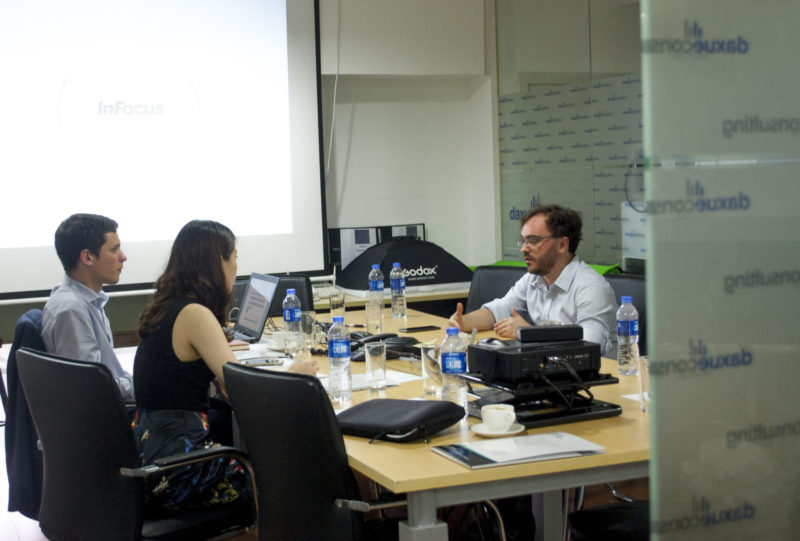
In the tourism industry and other practices, our clients share our passion for results and success. For more on our expert insights and our work in the Chinese market, please see our site, follow our newsletter, or reach out to us to learn more.
Feature photo: The museum visitors in China National Museum (国家博物馆), the No.1 most popular museum in China, which has had 7.75 million visitors in 2016. Source: China National Museum Website


